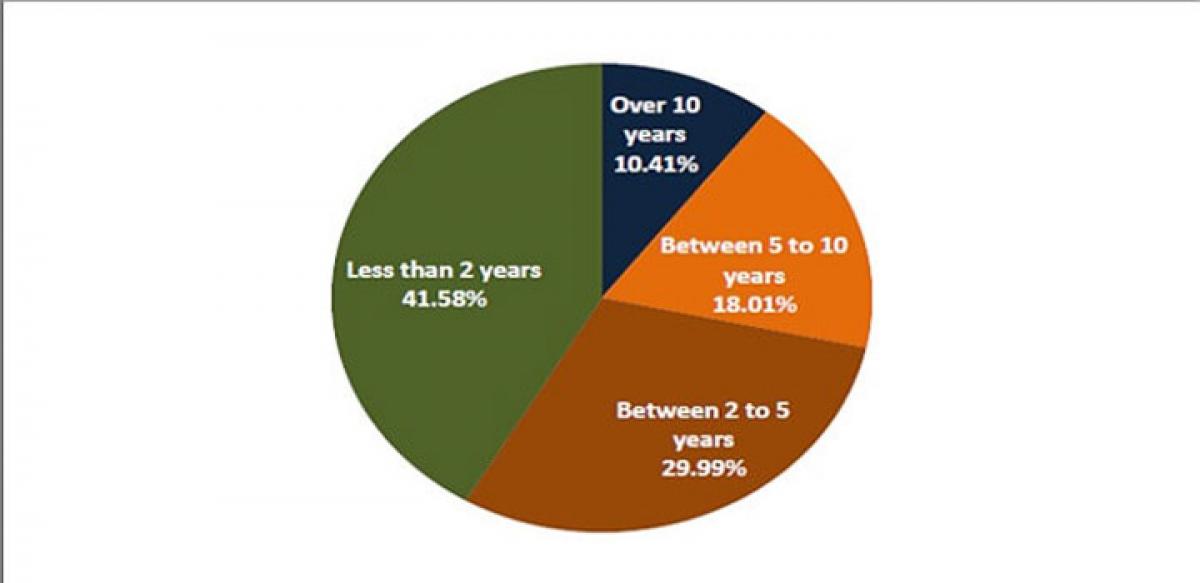Live
- Railway milestone: 18-coach trial run on Katra-Budgam track in J&K
- 22 Maoist militia members surrender
- Transforming MBNR’s academic landscape
- Demand for implementation of comprehensive caste census
- MLC Kavitha Welcomes Turmeric Board Announcement, Criticizes Exclusion from Inauguration
- EPFO simplifies process for funds transfer, correcting personal details
- Revanth Reddy and Sridhar Babu meets Capital land Group, announces major investment in Hyderabad
- Ganja and Hash Oil Seized in Madhapur: Two Arrested
- Sukriti Bandreddy Shines in 'Gandhi Tata Chettu': Sukumar Praises Daughter’s Performance
- Collector calls on everyone to maintain cleanliness
Just In

District courts groan under pendency of cases. The data of pending cases in the lower judiciary is hard to get by. The recently launched National Judicial Data Grid (NJGD) portal is a very important first step in that direction.
The data of pending cases in the lower judiciary is hard to get by. The recently launched National Judicial Data Grid (NJGD) portal is a very important first step in that direction. The data available in the portal indicates that more than 2 crore cases are pending in the district courts as on date. More than 2/3rd of the pending cases are criminal in nature while the rest are civil in nature. At the current rate, it might take more than 10 years for the pending cases to get cleared.
.jpg) The data on pendency, nature of pendency in all the district courts of the country is now available in the public domain. The NJGD portal has data on 15,342 judges in 459 districts across the country as on 27th September 2015. The total number of pending cases, in all the district courts, as on 27th September, 2015, is more than 2 crore. While 67 lakh of these are civil cases, rest of the 1.34 crore are criminal cases. The number of pending criminal cases is twice the number of pending civil cases.
The data on pendency, nature of pendency in all the district courts of the country is now available in the public domain. The NJGD portal has data on 15,342 judges in 459 districts across the country as on 27th September 2015. The total number of pending cases, in all the district courts, as on 27th September, 2015, is more than 2 crore. While 67 lakh of these are civil cases, rest of the 1.34 crore are criminal cases. The number of pending criminal cases is twice the number of pending civil cases.
Uttar Pradesh has the highest number of pending cases with 46.73 lakh followed by Maharashtra at 29.57 lakh. The other states in the top six are Gujarat (20.83 lakh), West Bengal (13.83 lakh), Bihar (13.41 lakh) & Rajasthan (12.55 lakh). The top three states of Uttar Pradesh, Maharashtra & Gujarat account for more than 48% of these pending cases. Out of the 2 crore pending cases, more than 10% have been pending for over 10 years while 18% are pending between 5 and 10 years.
About 30% have been pending for 2 to 5 years while the remaining 41.6% have been pending for less than 2 years. In other words, 3 out of every 10 pending cases are more than 5 years old. There are wide variations within states in the nature of pending cases. For example, 24% of the cases pending in Gujarat are over 10 years old, while this percentage is less than 1% for states like Kerala, Punjab and Haryana etc. In 15 states, more than 50% of the pending cases are less than 2 years old.
The NJDG portal has data as on date and also has data for the last month (August 2015). More than 5.24 lakh cases were filed last month while 6.87 lakh cases were disposed last month. The four states of Maharashtra, Uttar Pradesh, Karnataka & Haryana account for more than 50% of the all the cases filed and disposed. More than a lakh cases were filed in Maharashtra last month. In states like Bihar, Gujarat, Jharkhand, West Bengal & Maharashtra, the number of cases filed was more than the number of cases disposed in the last month.
While the data for one month is not representative of the entire year, August was a normal month without any major court holidays. If the rate of filing and disposal in August is taken into consideration, then it would take little more than 10 years to clear all pending cases at an All India level. While civil cases might take 17 years to get cleared, the criminal cases might take a little more than 8 years.
Within states, there is again a wide variation in the rate of disposal. Six states (Bihar, Gujarat, Jharkhand, West Bengal, Maharashtra, and Jammu & Kashmir) would never be able to clear the pending cases given their performance in August. Nine states including Karnataka, Kerala, Assam, Andhra Pradesh & Telangana would be able to clear the pending cases in fewer than five years. Odisha might take more than 36 years to clear all pending cases given the current rate.
The NJDG portal is a very important first step in making data of the lower judiciary available in the public domain. It has data & information up to the individual case level including the list of hearing dates, copy of the order etc. The only glitch in the portal is availability of data for more months (archival data). The portal should have historic data and not just data for the last month.
By Rakesh Dubbudu

© 2025 Hyderabad Media House Limited/The Hans India. All rights reserved. Powered by hocalwire.com







